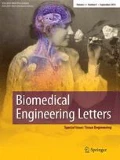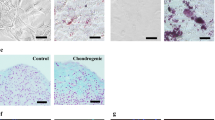Abstract
This is the first study demonstrating the efficacy of menstrual blood-derived stem cell (MenSC) transplantation via decellularized human amniotic membrane (DAM), for the promotion of skin excisional wound repair. The DAM was seeded with MenSCs at the density of 3 × 104 cells/cm2 and implanted onto a rat’s 1.50 × 1.50 cm2 full-thickness excisional wound defect. The results of wound closure and histopathological examinations demonstrated that the MenSC-seeded DAM could significantly improve the wound healing compared with DAM-treatment. All in all, our data indicated that the MenSCs can be a potential source for cell-based therapies to regenerate skin injuries.


Similar content being viewed by others
References
Chandika P, Ko S-C, Jung W-K. Marine-derived biological macromolecule-based biomaterials for wound healing and skin tissue regeneration. Int J Biol Macromol. 2015;77:24–35.
Sundaramurthi D, Krishnan UM, Sethuraman S. Electrospun nanofibers as scaffolds for skin tissue engineering. Polym Rev. 2014;54(2):348–76.
Alrubaiy L, Al-Rubaiy KK. Skin substitutes: a brief review of types and clinical applications. Oman Med J. 2009;24(1):4.
Mansbridge J. Skin tissue engineering. J Biomater Sci Polym Ed. 2008;19(8):955–68.
Priya SG, Jungvid H, Kumar A. Skin tissue engineering for tissue repair and regeneration. Tiss Eng Part B Rev. 2008;14(1):105–18.
Kim SS, et al. Effects of human amniotic membrane grafts combined with marrow mesenchymal stem cells on healing of full-thickness skin defects in rabbits. Cell Tissue Res. 2009;336(1):59.
Ilic D, et al. Human amniotic membrane grafts in therapy of chronic non-healing wounds. Br Med Bull. 2016;117(1):59–67.
Ishino Y, et al. Amniotic membrane as a carrier for cultivated human corneal endothelial cell transplantation. Invest Ophthalmol Vis Sci. 2004;45(3):800–6.
Niknejad H, et al. Properties of the amniotic membrane for potential use in tissue engineering. Eur Cells Mater. 2008;15:88–99.
Dua HS, et al. The amniotic membrane in ophthalmology. Surv Ophthalmol. 2004;49(1):51–77.
Cooper LJ, et al. An investigation into the composition of amniotic membrane used for ocular surface reconstruction. Cornea. 2005;24(6):722–9.
Motamed S, et al. Cell-based skin substitutes accelerate regeneration of extensive burn wounds in rats. Am J Surg. 2017;214(4):762–9.
Grueterich M, Espana EM, Tseng SC. Ex vivo expansion of limbal epithelial stem cells: amniotic membrane serving as a stem cell niche. Surv Ophthalmol. 2003;48(6):631–46.
Duscher D, et al. Stem cells in wound healing: the future of regenerative medicine? A mini-review. Gerontology. 2016;62(2):216–25.
Rodrigues MCO et al. Menstrual blood-derived stem cells: in vitro and in vivo characterization of functional effects. In: Biobanking and cryopreservation of stem cells. Berlin: Springer; 2016. pp. 111–121.
Faramarzi H, et al. The potential of menstrual blood-derived stem cells in differentiation to epidermal lineage: a preliminary report. World J Plast Surg. 2016;5(1):26.
Alcayaga-Miranda F, et al. Characterization of menstrual stem cells: angiogenic effect, migration and hematopoietic stem cell support in comparison with bone marrow mesenchymal stem cells. Stem Cell Res Ther. 2015;6(1):32.
Chen L, et al. Human menstrual blood-derived stem cells ameliorate liver fibrosis in mice by targeting hepatic stellate cells via paracrine mediators. Stem Cells Transl Med. 2017;6(1):272–84.
Lin J, et al. Plasticity of human menstrual blood stem cells derived from the endometrium. J Zhejiang Univ-Sci B. 2011;12(5):372–80.
Vu NB et al. Human menstrual blood-derived stem cell transplantation for acute hind limb ischemia treatment in mouse models. In: Regenerative Medicine. Berlin: Springer; 2015. pp. 205–215.
Verdi J, et al. Endometrial stem cells in regenerative medicine. J Biol Eng. 2014;8(1):20.
Farzamfar S, et al. Sciatic nerve regeneration by transplantation of menstrual blood-derived stem cells. Mol Biol Rep. 2017;44(5):407–12.
Naseri-Nosar M, et al. Cerium oxide nanoparticle-containing poly (ε-caprolactone)/gelatin electrospun film as a potential wound dressing material: in vitro and in vivo evaluation. Mater Sci Eng C. 2017;81:366–72.
Wu Y, et al. Mesenchymal stem cells enhance wound healing through differentiation and angiogenesis. Stem Cells. 2007;25(10):2648–59.
Chen L, et al. Paracrine factors of mesenchymal stem cells recruit macrophages and endothelial lineage cells and enhance wound healing. PLoS One. 2008;3(4):e1886.
Sasaki M, et al. Mesenchymal stem cells are recruited into wounded skin and contribute to wound repair by transdifferentiation into multiple skin cell type. J Immunol. 2008;180(4):2581–7.
Nakagawa H, et al. Human mesenchymal stem cells successfully improve skin-substitute wound healing. Br J Dermatol. 2005;153(1):29–36.
Maxson S, et al. Concise review: role of mesenchymal stem cells in wound repair. Stem cells translational medicine. 2012;1(2):142–9.
Walter M, et al. Mesenchymal stem cell-conditioned medium accelerates skin wound healing: an in vitro study of fibroblast and keratinocyte scratch assays. Exp Cell Res. 2010;316(7):1271–81.
Xiang B, et al. Transplantation of menstrual blood-derived mesenchymal stem cells promotes the repair of LPS-induced acute lung injury. Int J Mol Sci. 2017;18(4):689.
Badiavas EV, et al. Participation of bone marrow derived cells in cutaneous wound healing. J Cell Physiol. 2003;196(2):245–50.
Kim W-S, et al. Wound healing effect of adipose-derived stem cells: a critical role of secretory factors on human dermal fibroblasts. J Dermatol Sci. 2007;48(1):15–24.
Li L, et al. How to improve the survival of transplanted mesenchymal stem cell in ischemic heart? Stem Cells Int. 2016;2016:14.
Hyun JS, et al. Enhancing stem cell survival in vivo for tissue repair. Biotechnol Adv. 2013;31(5):736–43.
Ankrum J, Karp JM. Mesenchymal stem cell therapy: two steps forward, one step back. Trends in molecular medicine. 2010;16(5):203–9.
Johnson KE, Wilgus TA. Vascular endothelial growth factor and angiogenesis in the regulation of cutaneous wound repair. Adv Wound Care. 2014;3(10):647–61.
Wang X, et al. Feedback activation of basic fibroblast growth factor signaling via the Wnt/β-catenin pathway in skin fibroblasts. Front Pharmacol. 2017;8:32.
Schreier T, Degen E, Baschong W. Fibroblast migration and proliferation during in vitro wound healing. Res Exp Med. 1993;193(1):195–205.
Akhavan-Tavakoli M, et al. In vitro differentiation of menstrual blood stem cells into keratinocytes: a potential approach for management of wound healing. Biologicals. 2017;48:66–73.
Lee DE, Ayoub N, Agrawal DK. Mesenchymal stem cells and cutaneous wound healing: novel methods to increase cell delivery and therapeutic efficacy. Stem Cell Res Therapy. 2016;7(1):37.
Nikoo S, et al. Effect of menstrual blood-derived stromal stem cells on proliferative capacity of peripheral blood mononuclear cells in allogeneic mixed lymphocyte reaction. J Obstet Gynaecol Res. 2012;38(5):804–9.
Author information
Authors and Affiliations
Corresponding author
Ethics declarations
Conflict of interest
The authors declare that they have no conflict of interest.
Ethical statement
Animal experiments were approved by the ethical committee of Shahroud University of Medical Sciences and were carried out in accordance with the university’s guidelines.
Rights and permissions
About this article
Cite this article
Farzamfar, S., Salehi, M., Ehterami, A. et al. Promotion of excisional wound repair by a menstrual blood-derived stem cell-seeded decellularized human amniotic membrane. Biomed. Eng. Lett. 8, 393–398 (2018). https://doi.org/10.1007/s13534-018-0084-1
Received:
Revised:
Accepted:
Published:
Issue Date:
DOI: https://doi.org/10.1007/s13534-018-0084-1




